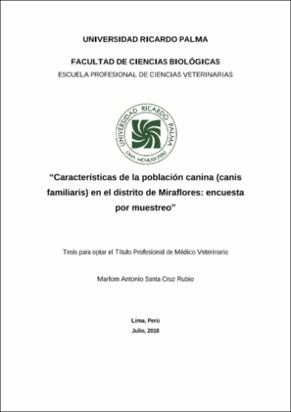| dc.contributor.advisor | Málaga Cruz, Hernán | |
| dc.contributor.author | Santa Cruz Rubio, Marlom Antonio | |
| dc.date.accessioned | 2019-02-20T18:49:56Z | |
| dc.date.available | 2019-02-20T18:49:56Z | |
| dc.date.issued | 2018 | |
| dc.identifier.uri | https://hdl.handle.net/20.500.14138/1689 | |
| dc.description.abstract | Este estudio se realizó con el fin de estimar la población canina y describir sus principales características demográficas en el distrito de Miraflores. La Metodología usada fue desacuerdo a lo descrito en la guía de Caracterización de Población Animal del Centro Panamericano de Fiebre Aftosa. El instrumento usado (encuesta) fue validado por el método de evaluación de expertos, teniendo como representantes a funcionario de áreas como Ministerio de Salud (MINSA), La Dirección General de Salud Ambiental (DIGESA), y catedráticos de la Universidad Ricardo Palma. Para la estimación de los canes se utilizó los datos recolectados en las encuestas, teniendo como referencia al Censo de población del Instituto Nacional de Estadística e Informática (INEI) del año 2007. De los resultados se evidencio que el porcentaje de viviendas con perros fue de 53% con una media de perros por vivienda de 1.25. La relación de persona: perro fue de 4.98:1. El estimado de canes alcanzo una cifra de 17 081 para finales del 2016. La relación de machos y hembras fue de un 1.06, determinando el 51,4% de los casos como machos y 48,6% como hembras. El 94.95% cumple una función de compañía. La tasa de natalidad fue calculada en 19,1%, fertilidad general en 52,7% y tamaño de camada promedio de 3.04 crías.
To estimate the dog population and describe its main demographic characteristics in the district of Miraflores. Methodology: It was developed through surveys as a data collection instrument, the sampling followed the guidelines designated in the Animal Population Characterization guide of the Pan American Foot-and-Mouth Disease Center, which were intended for the residents of the district and should be distributed by surveyors those who were properly trained and registered their signature at the end of the survey. The instrument used was validated by the expert evaluation method, having as representatives of areas such as Ministry of Health (MINSA), General Directorate of Environmental Health (DIGESA), and professors from the Ricardo Palma University. For the estimate of the dogs, the data from the National Institute of Statistics and Informatics (INEI) 2007 Population Census were used. Results and Conclusions: It was evidenced that the percentage of houses with dogs was 53% and an average of dogs per house of 1.25. The person: dog ratio was 4.98: 1. The estimate of dogs reached 17 081. The ratio of males and females was 1.06, determining 51.4% of the cases as males and 48.6% females. 94.95% has a company function. The birth rate was calculated at 19.1%, general fertility at 52.7% and average litter size was 3.04 offspring. | es_ES |
| dc.description.sponsorship | Submitted by Wong Rafael (rafel_wl@hotmail.com) on 2019-02-20T18:49:56Z
No. of bitstreams: 1
Santa Cruz_ma.pdf: 2208527 bytes, checksum: d4c766a11b1bf8d782cf2fa4024d13b9 (MD5) | es_ES |
| dc.description.sponsorship | Made available in DSpace on 2019-02-20T18:49:56Z (GMT). No. of bitstreams: 1
Santa Cruz_ma.pdf: 2208527 bytes, checksum: d4c766a11b1bf8d782cf2fa4024d13b9 (MD5)
Previous issue date: 2018 | es_ES |
| dc.description.uri | Tesis | es_ES |
| dc.format | application/pdf | |
| dc.language.iso | spa | |
| dc.publisher | Universidad Ricardo Palma - URP | es_ES |
| dc.rights | info:eu-repo/semantics/openAccess | |
| dc.rights.uri | https://creativecommons.org/licenses/by-nc-nd/4.0/ | |
| dc.source | Repositorio Institucional - URP | es_ES |
| dc.subject | Estimación canina | es_ES |
| dc.subject | Miraflores | es_ES |
| dc.subject | Caracterización de población | es_ES |
| dc.subject | Canine estimate | es_ES |
| dc.subject | population characterization | es_ES |
| dc.title | “Características de la población canina (canis familiaris) en el distrito de Miraflores: encuesta por muestreo” | es_ES |
| dc.type | info:eu-repo/semantics/bachelorThesis | |
| thesis.degree.discipline | Medicina Veterinaria | es_ES |
| thesis.degree.grantor | Universidad Ricardo Palma. Facultad de Ciencias Biológicas. Escuela Profesional de Ciencias Veterinarias | es_ES |
| thesis.degree.level | Título Profesional | es_ES |
| thesis.degree.name | Médico Veterinario | es_ES |
| dc.publisher.country | PE | es_ES |
| dc.subject.ocde | https://purl.org/pe-repo/ocde/ford#4.03.01 | |
| renati.advisor.orcid | https://orcid.org/0000-0001-7164-774X | |
| renati.type | https://purl.org/pe-repo/renati/type#tesis | |
| renati.level | https://purl.org/pe-repo/renati/nivel#tituloProfesional | |
| renati.discipline | 841016 | |
| renati.juror | Leguia Puente, Guillermo Manuel | |
| renati.juror | Jara Aguirre, Mauricio Rodolfo | |
| renati.juror | Bengoa Arenaza, Marcelino Eliseo | |
| dc.type.version | info:eu-repo/semantics/publishedVersion | |
| renati.author.dni | 46971095 | |
| renati.advisor.dni | 46971095 | |


